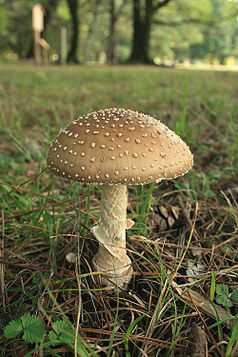Phalloidin
| Phalloidin | ||
|---|---|---|
 | ||
| Identifiers | ||
| CAS number | 17466-45-4 | |
| PubChem | 441542 | |
| Properties | ||
| Molecular formula | C35H48N8O11S | |
| Molar mass | 788.87 g mol−1 | |
| Appearance | Needles | |
| Melting point | 281 °C; 538 °F; 554 K ((hyd)) | |
| Except where noted otherwise, data are given for materials in their standard state (at 25 °C (77 °F), 100 kPa) | ||
| Infobox references | ||
Phalloidin is one of a group of toxins from the death cap (Amanita phalloides) known as phallotoxins.
Background
Pioneering work on this toxin was done by the Nobel laureate Heinrich Wieland in the 1930s. Phalloidin was ultimately purified and crystallized in 1937 by Heinrich's student and son-in-law Feodor Lynen (who won a Nobel Prize in 1964 for his work on cholesterol metabolism), and Heinrich's nephew Ulrich Wieland.[1]
Function
Phalloidin binds F-actin, preventing its depolymerization and poisoning the cell. Phalloidin binds specifically at the interface between F-actin subunits, locking adjacent subunits together. Phalloidin, a bicyclic heptapeptide, binds to actin filaments much more tightly than to actin monomers, leading to a decrease in the rate constant for the dissociation of actin subunits from filament ends, which essentially stabilizes actin filaments through the prevention of filament depolymerization.[2] Moreover, phalloidin is found to inhibit the ATP hydrolysis activity of F-actin.[3] Thus, phalloidin traps actin monomers in a conformation distinct from G-actin and it stabilizes the structure of F-actin by greatly reducing the rate constant for monomer dissociation, an event associated with the trapping of ADP.[3] Overall, phalloidin is found to react stoichiometrically with actin, strongly promote actin polymerization, and stabilize actin polymers.[4]
Phalloidin functions differently at various concentrations in cells. When introduced into the cytoplasm at low concentrations, phalloidin recruits the less polymerized forms of cytoplasmic actin as well as filamin into stable “islands” of aggregated actin polymers, yet it does not interfere with stress fibers, i.e. thick bundles of microfilaments.[4] Wehland et al. also notes that at higher concentrations, phalloidin induces cellular contraction.
Use as an imaging tool

The properties of phalloidin make it a useful tool for investigating the distribution of F-actin in cells by labeling phalloidin with fluorescent analogs and using them to stain actin filaments for light microscopy. Fluorescent derivatives of phalloidin have turned out to be enormously useful in localizing actin filaments in living or fixed cells as well as for visualizing individual actin filaments in vitro.[2] A high-resolution technique was developed to detect F-actin at the light and electron microscopic levels by using phalloidin conjugated to the fluorophore eosin which acts as the fluorescent tag.[5] In this method known as fluorescence photo-oxidation, fluorescent molecules can be utilized to drive the oxidation of diaminobenzidine (DAB) to create a reaction product that can be rendered electron dense and detectable by electron microscopy.[5] The amount of fluorescence visualized can be used as a quantitative measure of the amount of filamentous actin there is in cells if saturating quantities of fluorescent phalloidin are used.[2] Consequently, immunofluorescence microscopy along with microinjection of phalloidin can be used to evaluate the direct and indirect functions of cytoplasmic actin in its different stages of polymer formation.[4] Therefore, fluorescent phalloidin can be used as an important tool in the study of actin networks at high resolution.
Limitations
Unmodified phalloidins do not permeate cell membranes, making them less effective in experiments with living cells. Derivatives of phalloidin with greatly increased cell permeability have been synthesized.[6]
Cells treated with phalloidins exhibit a number of toxic effects and frequently die.[2] Furthermore, it is important to note that phalloidin-treated cells will have greater levels of actin associated with their plasma membranes, and the microinjection of phalloidin into living cells will change actin distribution as well as cell motility.[2]
See also
References
- ↑ Feodor Lynen, Ulrich Wieland (1938). "Über die Giftstoffe des Knollenblätterpilzes". Justus Liebig's Annalen der Chemie 533 (1): 93–117. doi:10.1002/jlac.19385330105.
- ↑ 2.0 2.1 2.2 2.3 2.4 Cooper JA (October 1987). "Effects of cytochalasin and phalloidin on actin". J. Cell Biol. 105 (4): 1473–8. doi:10.1083/jcb.105.4.1473. PMC 2114638. PMID 3312229.
- ↑ 3.0 3.1 Barden JA, Miki M, Hambly BD, Dos Remedios CG (February 1987). "Localization of the phalloidin and nucleotide-binding sites on actin". Eur. J. Biochem. 162 (3): 583–8. doi:10.1111/j.1432-1033.1987.tb10679.x. PMID 3830158.
- ↑ 4.0 4.1 4.2 Wehland J, Osborn M, Weber K (December 1977). "Phalloidin-induced actin polymerization in the cytoplasm of cultured cells interferes with cell locomotion and growth". Proc. Natl. Acad. Sci. U.S.A. 74 (12): 5613–7. doi:10.1073/pnas.74.12.5613. PMC 431831. PMID 341163.
- ↑ 5.0 5.1 Capani F, Deerinck TJ, Ellisman MH, Bushong E, Bobik M, Martone ME (1 November 2001). "Phalloidin-eosin followed by photo-oxidation: a novel method for localizing F-actin at the light and electron microscopic levels". J. Histochem. Cytochem. 49 (11): 1351–61. doi:10.1177/002215540104901103. PMID 11668188.
- ↑ http://www.emdmillipore.com/life-science-research/phalloidin-oleate/EMD_BIO-516641/p_Z_ab.s1L_9oAAAEWhmEfVhTm?PortalCatalogID=merck4biosciences&CountryName=United+States+of+America
| |||||||||||||||||||||||||||||||||||||||||||||||||
